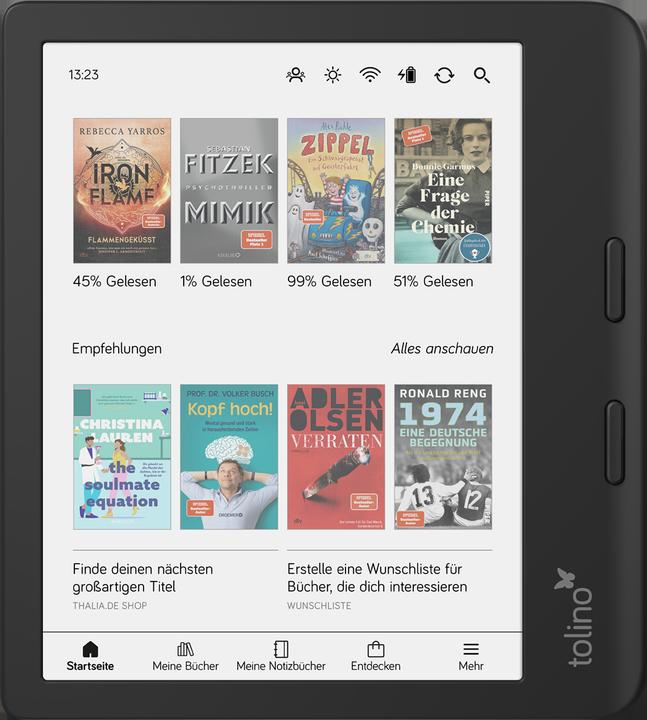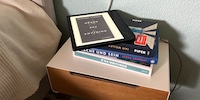

Tolino Vision Color: this e-reader’s aiming a little too high
The Vision Color from Tolino is a colour e-book reader that doubles as a notepad you use with a stylus. Sounds good, but the concept has a few weaknesses.
Looking for a solid, compact e-reader? Are most things you read in black and white? Do you prefer to take notes on real paper? Then there’s no need to read on and you can go ahead and buy the Tolino Shine 5, which I also recently tested. Here’s my full review.
The Vision Color, on the other hand, might be interesting for you if you regularly read publications in colour, i.e. comics, children’s books or non-fiction books containing colourful illustrations. Maybe you’re a pupil, an apprentice or a student who’d like to take notes or highlight passages in books and documents. I paid particular attention to these two aspects when testing the Vision Color.
4,096 pale colours
The Vision Color is equipped with an E-Ink Kaleido 3 display with 1,264 × 1,680 pixels. It can display 4,096 colours, 16 shades of grey and has a resolution of 150 ppi in colour and 300 ppi in black and white. According to the display manufacturer, the colour saturation is 30 per cent better than with its predecessor.
In practice, however, the colours on the Vision Color are disappointingly pale – especially when it comes to, let’s say, a Mickey Mouse magazine.
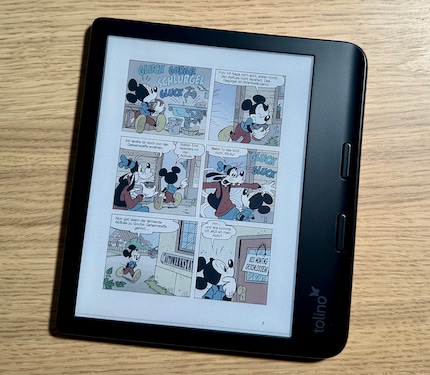
Nevertheless, it’s fun to look at colourful content on the Vision Color. The fact that the overview of my books shows all the covers in colour is a real plus. Besides, you get used to the anaemic look quite quickly. If you’re a comic book fan, you’ll appreciate that you can store your entire collection of comics on one device.
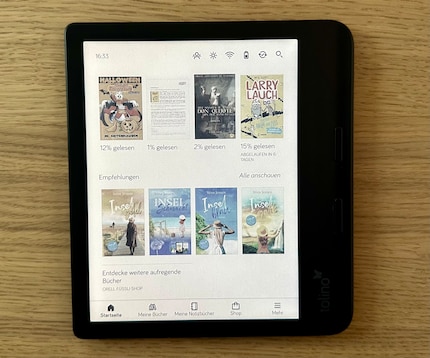
Comics and graphic novels are comfortable to read in A5 format; the 7-inch screen of the Vision Color’s made for this. I tried to read an Asterix book as part of my review and gave up. The constant zooming in to be able to read the speech bubbles and the scrolling back and forth to see the whole page got on my nerves after just ten minutes. The processor and RAM in the Vision Color aren’t designed for this either. Processing coloured content in particular pushes it to its performance limits. Zooming in or turning pages just isn’t as fast as on an iPad or smartphone. At times, it takes about a second. Once, I even crashed the operating system because I was overdoing it, it seems.

Colour comes at the expense of sharpness
Because the Vision Color’s all about colour, it loses out to the competition in terms of sharpness. Especially compared to other products from the same company. The black and white version of the recently released Shine 5, for example, displays text in crisp detail. The Vision Color’s at a slight disadvantage here due to the technology its colour display uses: an LCD layer on top of a layer containing black and white microcapsules, through which red, yellow or blue can be displayed. If you’re interested in the physical and technical details of this structure, there’s a good explanation in this article.
When I’m reading a regular e-book on the Vision Color, the background looks a little blurry to me. Even at the highest brightness level, those tiny colour elements of the additional layer remain visible and cloud the reading experience with pure text.
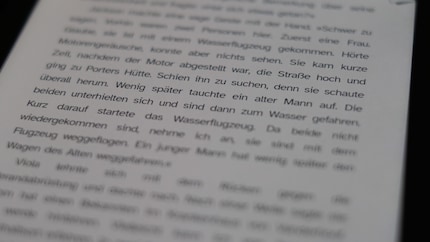
Notes and highlights
The optional stylus turns the Vision Color into a notepad. Essentially, you can do the following two things with it:
- Highlight text passages in books and documents.
- Write and draw in your own notepad.

The stylus costs just under 70 francs. It has a USB-C port for charging, an end that works like an eraser and a tip that comes in three sizes. The highlighter function is activated by a button at the top third of the pen. In addition, you can magnetically stick the stylus to the side of the reader, which is a very handy feature.
Highlighting text passages
If you’re writing a paper or preparing a presentation, it’s likely you’ll be reading through various documents and working your way through books. You’ll probably also be highlighting text passages or jotting down some notes. And that’s precisely what the Tolino stylus is for. You can use it like a ballpoint pen and even choose between various colours to highlight passages.
What’s weird is that notes I’ve made disappear when I change the size of the font. Instead of scaling them, the notes are saved as a screenshot. This means, they’re still visible in the margin of the text. To display them, you need to click on them.
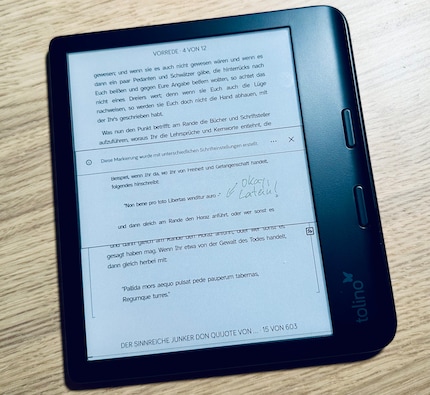
Taking notes
In addition to the ballpoint pen and highlighter, the notepad also includes other writing utensils: a fountain pen, calligraphy pen and a brush. These are all pressure sensitive. This means your stroke will be wider if you press the stylus down more firmly or hold it at an angle. If I were more artistic, I could probably produce reasonably usable drawings with it.
You can even jot down a mathematical formula and do your calculations on the spot. Or sketch a diagram or infographic, which is then translated into clean geometric shapes. However, this didn’t always work smoothly in my test. An infographic bar I drew was turned into an «H» or a «D».
Let’s get back to the written word, though. After all, I’m a journalist by trade. What I like about the Vision Color is that it has outstanding handwriting recognition. Even though my writing’s even worse on a smooth surface than it is on paper, the software recognises my scribbling and turns it into block letters. This happens as quick as a flash, which surprises me because the Vision Color isn’t much of a racehorse when computing power’s required.
In theory, you could take handwritten notes while you’re on the move, save them to the notepad and continue working on them later. However, I didn’t take many notes during the test period. Why? Because of the size of the Vision Color. There’s simply nowhere to rest your palm when you’re writing. I keep ending up on the edge of the device or accidentally touching the display and opening a menu. And I find writing without putting my hand down too tiring in the long run.
What else does it do?
In addition to its colour display and notepad feature, the Vision Color combines everything you’d expect from a good e-book reader. It’s solidly built, waterproof and lies really well in your hand. I’m a fan of its form factor, too. Its slightly wider edge on one side and the two scroll buttons allow for easy reading using just one hand. The device also has a rotation sensor. This means you can hold the reader any way you like and the text will always be displayed the right way.
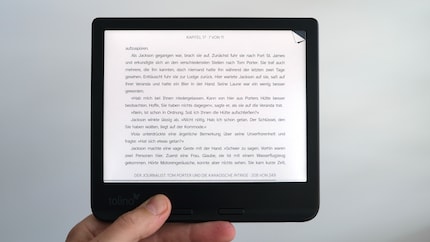
I’m happy with the storage space and runtime of the device. The only thing that affected the battery in my test was excessive use of the notepad function. Otherwise, the e-ink technology is frugal. So you can leave the Vision Color in a drawer for weeks and it’ll still be ready for use when you feel like reading a book.
When it comes to readable formats, the Vision Color isn’t very picky. It can handle pretty much anything – epub, mobi, cbz, cbr, you name it. The only time you need to take a detour via your computer is for books from other sources with Adobe DRM copy protection.
In theory, this can also be done via the browser installed on the Vision Color, but I didn’t have the patience for this. Even in 2024, I still wouldn’t recommend e-readers for surfing the internet.
You’re better off sitting back with your headphones on and having a book read to you. Fortunately, this is now possible thanks to its new software that allows the Vision Color to play back audiobooks. Not over its own speaker (which it doesn’t have), but over a speaker or headphones connected via Bluetooth.
In a nutshell
A decent colour e-reader at an attractive price
Pro
- Long-lasting battery
- Flexible and supports many e-book formats
- Impressive handwriting recognition in the notepad
- Plays back audiobooks (via Bluetooth)
- Comfortable to hold, suitable for left- and right-handers
- Very sturdy finish and even waterproof
Contra
- Text display not as sharp as black and white readers
- Colours on the pale side
- Stylus not included
- CPU and RAM reach their limits quickly with colour content
Journalist since 1997. Stopovers in Franconia (or the Franken region), Lake Constance, Obwalden, Nidwalden and Zurich. Father since 2014. Expert in editorial organisation and motivation. Focus on sustainability, home office tools, beautiful things for the home, creative toys and sports equipment.
